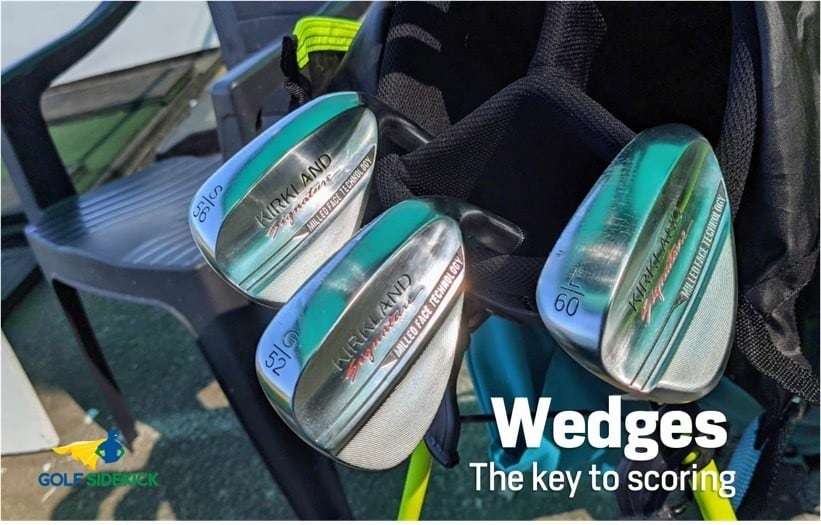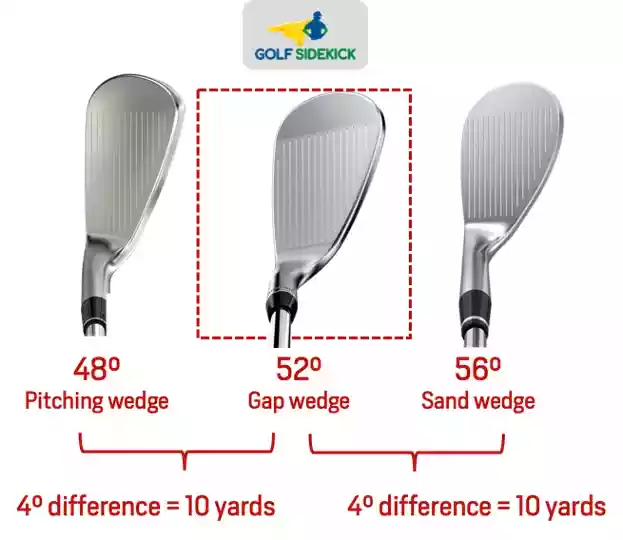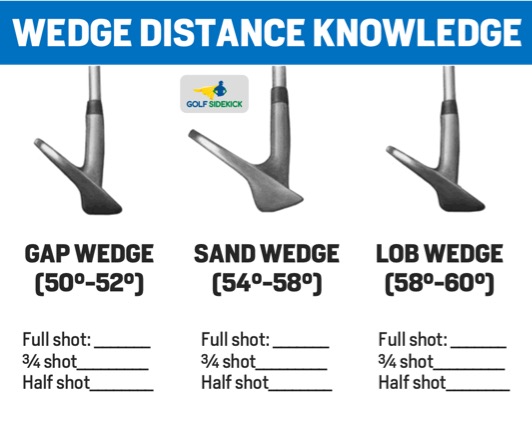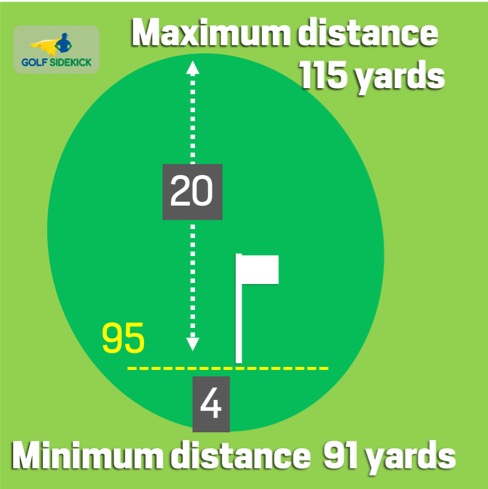Last Updated on January 27, 2024 by Matt Greene
Usually, golfers talk about how far they hit their tee shot, or their 7 iron but we rarely ask "how far should you hit your wedges?"
On my Youtube channel, I hammer home the importance of the game inside 125 yards where the shots are shaved. It's called the scoring zone, where you reduce your handicap.
You must know how far each of your wedges go. It's also important to have consistent distance control with the pitching wedge, gap wedge and sand wedge so you hit the ball closer to the hole.
So how far should you hit your wedges? Different wedges have different degree lofts. The distances for average male golfers are between these distance ranges:
- Lob wedge (60 degrees) 50 to 80 yards
- Sand wedge (56 degrees) 65 to 90 yards
- Gap wedge (52 degrees) 80 to 110 yards
- Pitching wedge (48 degrees) 90 to 120 yards

It does not matter if you fall into the average above or not. The important part is:
- You must KNOW your carry distance with each wedge honestly and accurately!
- We cannot use our ego distance for wedges. It's about precision, not power.
- Controlling the distance of each wedge is the key once you know the distance that you hit them, 8 out of 10 times.
- When you know how far you hit each wedge, you can plan to leave yourself your favorite distances to the hole on your approach.
- The wedge game is the key to scoring in golf whether you're a low, mid or high handicapper. Keep in mind though, the wedges will not miraculously bring you more birdies.
- The wedge game reduces the big numbers on your scorecard down to bogeys and double bogeys.
Wedge Distance Chart
CLUB | LOFT | DISTANCE |
| (Degrees) | (Yards) | |
| Pitching wedge | 45-48 | 90-120 |
| Gap wedge | 49-53 | 80-110 |
| Sand wedge | 54-58 | 65-95 |
| Lob wedge | 58-60 | 60-80 |

What degree is a gap/approach wedge?
- The gap or approach wedge has a loft of 52 degrees.
We use approach wedge and gap wedge as interchangeable names for the same club. The gap wedge or approach wedge exists as a club to plug the distance gap between your pitching wedge at 45 degrees and your sand wedge at 56 degrees. Each iron is separated by 3 or 4 degrees of loft in your iron set but your pitching wedge and sand wedge live 11 degrees apart.
We use the gap wedge or approach wedge to fit in between the PW and SW. You can differentiate between the gap wedge and approach wedge by looking at the letter stamped on the bottom of the club. The gap wedge shows a 'G' while the approach wedge shows an 'A'.
What degree is a pitching wedge?
- A pitching wedge has 45 degrees of loft.
Each manufacturer produces pitching wedges with different lofts based on whether the iron set is a players iron, a game improvement iron or a super game improvement iron. The super game improvement irons pitching wedges have a loft of 43 or 44 degrees while the game improvement pitching wedges use 44 or 45 degrees. Players iron sets contain pitching wedges with 46 or 47 degrees.
Clearly the loft of the pitching wedge decreases for less skilled golfers, and increases for more skilled golfers.
| Iron brand | Pitching wedge degrees |
| Taylormade SIM2 Max | 43.5° |
| Taylormade P790 | 45° |
| Taylormade P770 | 46° |
| Taylormade P7MB | 47° |
| Cobra King Radspeed | 42.5° |
| Cobra King Forged TEC | 44° |
| Cobra King Tour | 45° |
| Callaway Big Bertha B21 | 43° |
| Callaway Apex DCB | 43° |
| Callaway Apex | 43° |
| Callaway Apex Pro | 45° |
| Mizuno JPX921 Hot Metal | 44° |
| Mizuno JPX921 Forged | 45° |
| Mizuno JPX921 Tour | 46° |
| Mizuno MP20 | 46° |
| Mizuno MP20HMB | 46° |
Pitching Wedge Distance - How far should you hit a pitching wedge?
- The average distance male golfers with an average swing speed can hit the pitching wedge 100 yards.
- Faster swinging golfers will hit the pitching wedge 120-140 yards.
Pitching wedges vary in loft from 42 to 47 degrees which can make a huge difference in carry distance. A 42 degree pitching wedge can fly 10 yards further than a 47 degree pitching wedge when hit by the same golfer.
What degree is a sand wedge?
- A sand wedge has 56 degrees of loft.
Sand wedges in irons sets can vary from 54 to 56 degrees in loft but the traditional standard loft remains 56 degrees.
Most modern golf iron sets do not contain a sand wedge so you need to purchase a standalone sand wedge. That means you can exercise your own choice depending on your needs. If you do need a standalone sand wedge, any wedge with a loft of between 54 and 58 degrees will perform perfectly.
56 Degree Wedge Distance - How far should you hit a 56 degree?
- Your full shot should with a 56 degree wedge should fly 75 yards or more.
- Faster swinging golfers will hit the sand wedge 100-110 yards.
There is no reason to hit the sand wedge longer than 110 yards because at that stage, your ball spins far too much to control and the sand wedge performs as a finesse club, not a distance club.
What degree is a lob wedge?
- A lob wedge has 60 degrees in loft.
60 Degree Wedge Distance - How far should a 60 degree wedge go?
60 degree lob wedge should fly more than 60 yards. For faster swing speeds, the 60 degree wedge can carry 90-100 yards.
When to Use a 60 Degree Wedge
60 degree lob wedges are versatile and make excellent clubs for getting out of bunkers, lobbing the ball high over obstacles and for partial wedge shots.
Which Wedges Should I Carry?
A modern pitching wedge has 45 degrees of loft while a sand wedge has a loft of 56 degrees.
You can play great golf with only these two wedges.
After some experience, you may notice a large distance gap between the sand wedge and pitching wedge that you can fill with a gap wedge.
I recommend that if you have 1 year of experience in golf, then you should have 3 wedges – a pitching wedge, a gap wedge and a sand wedge. You should shoot for intervals of 4-6 degrees of loft between each wedge.
If your pitching wedge is 48 degrees, you can use a gap wedge between 50 or 52 degrees of loft and a sand wedge with 56 or 58 degrees.

Why Should I Have Many Wedges?
You should play 3 or 4 wedges so that you can hit the ball a specific distance when you really need to - when it counts.
When you have confidence in the distance you hit the ball with a certain wedge, you feel committed and hit the ball closer to the cup for an easier par or bogey save.

Inside wedge range, confidence is most important to avoid the dreaded fat shot or thin shot.
Having the correct wedge for the task reduces your stress and lowers your score.
You are a natural born scrambler
The degrees of loft you choose for your wedges do not matter if you focus on hitting specific distances.
You might find you hit your preferred distances with a weird set of lofts. That's perfect for you! It must make sense for YOUR game.
If you know the distance you hit with each wedge, then you have power in your game to score well, by knowing with confidence, that you will hit good shots.
If you are an average hobby golfer trying to break 90 or breaking 100 is a goal, you must understand that we just will not hit many greens in regulation. That means you need to know your wedge distances to hit more greens in regulation +1 shot for more par and bogey saves.
How can I accuse you of not hitting greens? Here's the data from Shotscope:
- 100 breakers will hit 1-2 greens in regulation
- 90 breakers will hit 2-4 greens in regulation
- 80 breakers will hit 4-8 greens in regulation
- par breakers will hit 8-12 greens in regulation
By default, we are scrambling with our wedges regardless of our handicap.
How to Measure How Far You Hit Your Wedges
There are three easy ways to learn your wedge distances:
- Go to a Trackman bay at an outdoor driving range or indoors. You can hit balls and the Trackman will collect the information for you and give you a great spread of data and your average number.
- Go to a field and hit your wedges. Try to see how much they are bouncing and where they land. You can leave a golf ball bag where you were hitting the balls and walk to where the balls were landing. You then shoot a rangefinder back to the bag from where you are standing. This is a very accurate way to know.
- You can check this out on the course. When you play a social or casual round, hit 3-4 balls to the green with your selected wedge from a known distance. Shoot the distance to the pin. hit the appropriate wedge and then over the entire round, notice how far short or how far long you were in relation to the pin. This is also a very accurate way to gauge your wedge distance. To make this even more accurate, use a GPS watch to track the distance from where you hit it to where it landed.
The key is to remember DO NOT use the AVERAGE number.
Use the distance number that comes up most often.
If the most common number for your PW is 110 and 113 and 115, then you know your wedge distance range is 110 to 115 yards. If you have a few outliers like 126 and 98, you should ignore those.
You have to remember to stay brutally honest with yourself.
Do not lie to yourself. Use the club that works, not the club that impresses other people. That is the best piece of advice you'll read today, I guarantee.
How to Hit the Partial Shots under 75 yards
To hit the partial wedge shots inside 75 yards, you need all of your wedges and ONE swing.
You have the FULL swing, but now you need a PARTIAL swing.
You can decide on the length of your partial swing. I use a feeling and the feeling doesn't need to be accurate, but it must be repeatable:
- 25%
- 50%
- 75%
Pick one of the percentages and practice making this partial swing the same length each time.
Substitute in each wedge and hit the ball with the percentage you chose.
For example, with the same 50% feeling swing, your pitching wedge will fly 60 yards, your gap wedge will fly 50 yards and your sand wedge will fly 40 yards.
All using the same swing. This is a simple way to get great inside partial wedge range.
How to Hit the In-Between Wedge Shots
What shot do you hit if you have 95 yards to the hole, but your gap wedge flies 90 and your pitching wedge flies 100-105?
It doesn't matters how many wedges you carry in the bag, you always seem to have these in -etween shots.
This is the key to hitting the partial shot:
You'll need a GPS watch.
Look at your GPS watch.
The back of the green is 115 yards. The front of the green is 91 yards.
Look at ALL that space behind the hole!

Ignore the flag!
You can hit the shot between 92 yards and 114 yards and stay on the green.
In this instance you should hit the pitching wedge because your distance range is 100-105 which is well short of 115 yards at the back edge. That means at the most you will have a 30 foot putt but you will be on the green even with a poor strike.
If you hit a 90 yard gap wedge, it can also work if the front of the green is flat and there is no hazard or chance of spinning down a hill. I would err on the side of caution and ignore the flag and get the ball to the middle of the green with a pitching wedge.
Play your approach shots to a distance range with your wedges. Finding a specific distance can prove very difficult depending on your level of skill.
Choosing wedges for your set
50 vs 52 Degree Wedge - which gap wedge is best?
My golf game improved when I filled the gap between my pitching wedge and sand wedge but which GW wins the battle between 50 vs 52 degree wedge?
I believe that the 50 degree wedge is the best option for the average golfer who wants to play three wedges. A 50 degree wedge will plug the gap nicely between PW and SW.
However, a 52 degree wedge might suit your game better depending on your bag set up so let's check some options for your situation.
50 or 52 Degree Wedge? What should I use?
The specific gap wedge you choose depends on the distance you hit your pitching wedge and sand wedge. You can select a gap wedge loft depending on which distance you would like to hit the gap wedge.
You do not need to work on degrees of loft, but on the distance you want to hit.
It also depends on the types of short game shots you play and the yardage gap you have with full swings.
Here's the set up I play:
- Pitching wedge: 46 degrees
- Gap wedge: 50 degrees
- Sand wedge: 54 degrees
- Lob wedge: 58 degrees
I prefer having nice 4 degree gaps between by wedges - I choose the 4 degree gap because I play the same brand in all my wedges. If you play different brands, you cannot use only degrees of loft to plug the gap.
My setup allows me to dial in my average distance with each club and have more control over the golf ball. The 50 degree also provides multiple shots around the green and form the bunkers.
What Is A 50 Degree Gap Wedge Used For?
- A 50 degree wedge is used for full approach shots into greens.
- We use a 50 degree wedge for short chip and pitch shots around the greens.
- The gap wedge provides a useful option for playing lower trajectory pitch shots and chip shots because of lower loft and less bounce than a sand wedge.
- The 50 degree wedges tops where it lands on partial shots, where a sand wedge hit to the maximum requires a firm strike and that creates too much back spin which is uncontrollable.
- 50 degree wedges work for longer bunker shots as it travels further than sand wedges with more roll out.
- You can also use a 50 degree gap wedge very effectively for wedge shots into the wind, where it has less spin than a 56 degree wedge and therefore won't balloon up into the sky.
What Is A 52 Degree Wedge Used For?
With only 2 more degrees of loft than the 50 degree wedge, 52 degree wedges fulfills a very similar role in a player's golf bag, but with a few minor differences.
- More loft means less distance but more spin so a 52 degree wedge is useful for partial shots into the green and for a specific yardage on full shots. By creating less spin on the partial shots, you can account for some more consistent bounce and roll.
- A 52 degree wedge is really useful for a bunker shot where the ball is plugged. You can't play these shots with a sand wedge without really manipulating the face of the golf club. You have to close the face so much that it points toward your shins. The 52 degree allows you to play a normal bunker shot and make solid contact. The ball should pop out with less spin and more roll.
50 Degree Wedge Distance
The average distance male golfers with average swing speed expect to hit their 50 degree wedge is 85 to 95 yards. Those who are big hitters, or are skilled enough to play full shots can hit the ball as far as 125 yards with their 50 degree gap wedge.
52 Degree Wedge Distance
How far does a 52 degree wedge go?
Average golfers hit their 52 degree wedge around 80 - 90 yards.
Of course this depends on the lie of the golf ball, swing speeds and other factors.
Most players will probably hit a 50 and 52 degree wedge the same distance.
Final Thoughts
You don't need to compare your distance to others.
The key is to KNOW your own distance with each wedge and with each swing so you can use your exact distances and shots to keep your score down with great wedge play.
Inside 125 yards is the vital part of golf and hitting the green 6 or 7 times out of 10 is a great achievement because even the pros only hit 70% of the greens from this distance.
Keep your wedge game strong!
